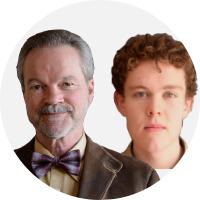The views expressed in our content reflect individual perspectives and do not represent the authoritative views of the Baha'i Faith.
Both of these phrases—“the attributes of God” and the various “names of God”—mean the same thing. But if God is one, how can many names or attributes of God exist?
The simple answer: although there are many “names of God,” there is only one God. That defines the basic proposition of all truly monotheistic religions. Many “attributes of God”—the qualities, energies and powers of the Creator—also exist. But this requires some explanation, because, as the Baha’i teachings explain, God is one in His attributes:
He, verily, is the Possessor of all wealth, the All-Wise, Who is one in His Essence, one is His attributes, and one in His acts, Who hath ever been peerless on the throne of majesty and singular on the seat of glory. … Thou art then witness that He is one in His attributes, and that all attributes are debarred from entry into the court of His holiness; this is what He hath ordained for His own Self, if ye be of them that apprehend this truth. Recognize, moreover, that the myriad worlds of names and attributes shall never be joined unto His Essence, for His attributes are verily His Essence Itself, and none shall ever know how this can be; in very truth, He is the Almighty, the Transcendent, the Forgiving, the Merciful. – Baha’u’llah, Tablet of the City of Divine Unity, provisional translation by Joshua Hall.
(A side note: God has no gender, and the pronoun “His” is actually gender-neutral in meaning. You can blame Arabic and English grammar for this default gender reference.)
Here, clearly God is “one in His attributes.” Baha’u’llah also refers to “the myriad worlds of names and attributes.” So we face the challenge of understanding the relationship between the one and the many.
From this series alone, readers have been introduced to a number of “godly perfections” that can be transformed into “goodly actions.” Therein lies the clue: a profound relationship unites all that is “godly” and all that is “goodly.”
So what do we mean by “godly”? “Godly” means something divine. But how can we understand “divine” beyond its obvious meaning? Baha’u’llah explains:
All these names and attributes refer to His Prophets, His Messengers, and His Elect, for they are the mirrors that reflect His attributes and are the Daysprings of His names; for otherwise, He, in His majesty, would lie hid and concealed in His Essence and attributes. All these beauteous names and sublime attributes are made manifest in His Prophets, lest any soul be entirely bereft of the knowledge of the divine attributes in the dominion of names; and this is a token of His grace unto all the worlds.
It is incumbent on him who is a true believer in this station to affirm that these attributes that are manifest in the Messengers of God are naught but His own attributes—exalted is He—in such wise that he seeth no separation between Himself and Them. Their attributes are revealed at His behest and created in conformity to His will; this, verily, is the true recognition of the oneness of God in this station. – Ibid.
 Suppose that we were to transform the metaphor of “mirrors” to “prisms.” Then this statement would mean something like this: “prisms that refract His attributes.” We know that a prism can turn white light into a rainbow, or a spectrum of colors.
Suppose that we were to transform the metaphor of “mirrors” to “prisms.” Then this statement would mean something like this: “prisms that refract His attributes.” We know that a prism can turn white light into a rainbow, or a spectrum of colors.
In much the same way, the messengers of God transform the pure light of God into various “colors,” metaphors for divine qualities, energies and powers, as previously mentioned.
That’s how “the one” becomes “the many”!
In this soul stirring and mystic “Tablet,” Baha’u’llah addresses the peoples of the world:
O peoples of the east and west! These are the breezes evincing Ḥá’ which wafted over the valley of transcendent glory in the Sinai of the spirit, a spot where none save God, the Almighty, the Kindly, is mentioned. … This is a city which, if one ailing enter therein, he is healed and made whole quicker than a word floweth from the tongue. And if the Kingdom of Names were to pass by it, these names, one and all, would become more glorious and would speak of God, in such wise that by a single one of these names all in the heavens and on earth would be revolutionized. – Ibid.
This “City of the Divine Unity” is a state of consciousness. Baha’u’llah invites you and I to visit this “City:”
Strive in thyself to enter this city, and if thou cannot, do thou listen with thy spirit, that haply thou mayest circle round it and perceive the sweet-scented breezes thereof wafting over thee. By God! Better is this for thee than that thou possess the dominion of the former and latter generations. This is My command unto thee and unto them that have ascended to an abode of manifest sovereignty. – Ibid.
What does the City of Divine Unity look like? What kind of experience waits for those who visit this celestial paradise? How can we comprehend this aspect of Baha’i mysticism? Here is Baha’u’llah’s description of that City:
And when this stage of the journey is completed and the wayfarer hath soared beyond this lofty station, he entereth the City of Divine Unity, and the garden of oneness, and the court of detachment. … For in this station, the City of Divine Unity, are to be found those who have entered within the ark of divine guidance and journeyed through the heights of divine unity.
Thou shalt behold the lights of beauty upon their faces and the mysteries of glory in their human temples. Thou shalt perceive the musk-laden fragrance of their words and behold the signs of His sovereignty in all their ways and doings. Nor wilt thou be veiled by the deeds of them that have failed to quaff from the crystal springs or to attain unto the cities of holiness. … The stages of this journey, station, and abode are clear and manifest to thee and require no further explanation. – Baha’u’llah, Gems of Divine Mysteries, p. 30, pp. 64–65.
So there you have it!
As a disclaimer, this article simply reflects our limited understanding. Others, no doubt, will offer profound insights into these mysteries.
Suffice it to say that mysticism, in part, is being able to see the extraordinary within the ordinary. This requires a deep sense of purpose, and training one’s perceptions. You can do it, if you choose to do so.

















Comments
Sign in or create an account
Continue with Facebookor